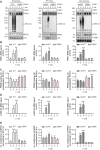Basal activity of PINK1 and PRKN in cell models and rodent brain
- PMID: 38041584
- PMCID: PMC11135862
- DOI: 10.1080/15548627.2023.2286414
Basal activity of PINK1 and PRKN in cell models and rodent brain
Abstract
The ubiquitin kinase-ligase pair PINK1-PRKN recognizes and transiently labels damaged mitochondria with ubiquitin phosphorylated at Ser65 (p-S65-Ub) to mediate their selective degradation (mitophagy). Complete loss of PINK1 or PRKN function unequivocally leads to early-onset Parkinson disease, but it is debated whether impairments in mitophagy contribute to disease later in life. While the pathway has been extensively studied in cell culture upon acute and massive mitochondrial stress, basal levels of activation under endogenous conditions and especially in vivo in the brain remain undetermined. Using rodent samples, patient-derived cells, and isogenic neurons, we here identified age-dependent, brain region-, and cell type-specific effects and determined expression levels and extent of basal and maximal activation of PINK1 and PRKN. Our work highlights the importance of defining critical risk and therapeutically relevant levels of PINK1-PRKN signaling which will further improve diagnosis and prognosis and will lead to better stratification of patients for future clinical trials.
Keywords: Mitophagy; PINK1; PRKN; Parkinson disease; parkin; ubiquitin.
Conflict of interest statement
Mayo Clinic, F.C.F., and W.S. have filed a patent related to PRKN activators. Additional funding sources to disclose but not pertinent to the current study include a grant from Amazentis SA (to W.S.). Z.K.W. serves as PI or Co-PI on projects/grants from Biohaven Pharmaceuticals, Inc., Neuraly, Inc., and Vigil Neuroscience, Inc., and is an external advisory board member for Vigil Neuroscience, Inc., and a consultant on neurodegenerative medical research for Eli Lilly & Company. All other authors declare they have no competing interests. This research was conducted in compliance with Mayo Clinic conflict of interest policies.
Figures



References
Publication types
MeSH terms
Substances
Grants and funding
LinkOut - more resources
Full Text Sources
Other Literature Sources
